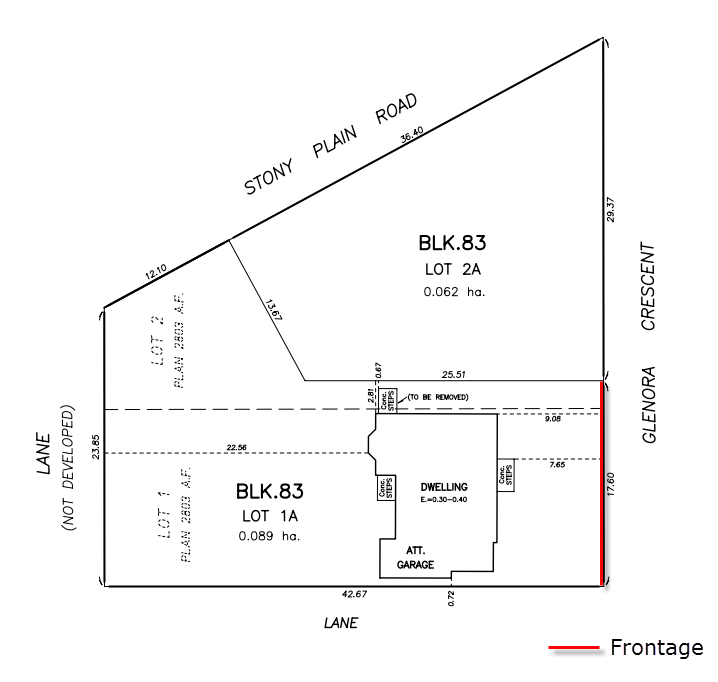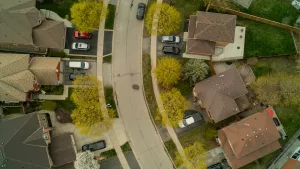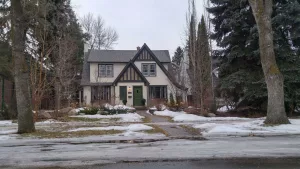What does Frontage Mean?
In real estate, frontage is the width of a lot, measured at the front part of the lot. In Edmonton real estate, the term frontage appears on most real estate listings – sometimes abbreviated as ‘Frntg’. There are typically two measurements for a lot, the frontage and the depth. Sometimes the terms road frontage or street frontage are used to describe the width of a lot as well. In commercial real estate, frontage may be described as “front foot.”
Real Estate Agent Explains Frontage
All municipalities and jurisdictions have different standard lot sizes. In Edmonton real estate, it is said that a standard lot (back in the 1950s or so) was “50 by 150,” meaning 50 feet wide, and 150 feet deep (or long). This means that the lot has a frontage of 50 feet. Although lots are not often as wide as 50 feet any longer, some older Edmotnon neighbourhoods may still have many lots of this size.

Oftentimes, frontage measurements on real estate listings are accompanied by depth measurements. By multiplying the two values, you get the size of the lot (provided the lot shape is rectangular). In the case of irregular lots (pie lots, reverse-pie lots), this calculation to find the size of the lot is not the same, but frontage is important regardless of the shape of the parcel of land. To learn more about the difference between the two measurements, see What is Better: Frontage or Depth?
Here is an example of the frontage (highlighted in red) of an irregular lot in Glenora, Edmonton:

This house is on Lot 1A and faces Glenora crescent, so the frontage is along that street. The frontage of this lot is 57.7 feet (17.6 metres).
With duplexes, attached housing or townhouse condominiums, the frontage is measured from the edge of the home to where the next home starts or the lot ends.
All lots in a city must have some sort of frontage to allow access to the property. This may not be the case in rural areas, however, where acreages and farmland may only be accessible via a right-of-way.
When comparing frontage or front foot, be sure the comparison is with the same amount of depth, otherwise you’re not making a reasonable comparison.
Why Does It Matter?
When it comes to real estate, more land is almost always better. The width of a lot is an important factor in determining the value of real estate. A wider lot will allow for a larger house, and often allow for more space between homes or buildings. Wide lots also allow decent parking on front streets or duplexes to be built on the lot as long as the zoning permits it.
It should be noted that there are times when frontage can also be a bit of trouble, as in cases where a front sidewalk needs to be shoveled in the winter or a wide boulevard needs to be maintained by the owner.
In the case of frontage in a commercial sense, larger is always more valuable as well. A lot can be long, or it can be wide – but if you want maximum exposure when it comes to advertising a business, you’ll want a wide building, not a long (or deep) one. A large amount of frontage means larger signs and possibly more storefront or window display area and the possibility of signage.
For more on why frontage is so important, see Why You Want to Buy Real Estate with Frontage.


Is it possible for a plot of land to not have any frontage? and how – if this is the case can this be remedied?
Hi Walter,
Some plots of land do not front on any roadway, so technically (depending on how you look at it) some land may have no frontage. Without changing the dimensions of the land, this is a permanent situation. That is, unless the parcel is re-drawn to include frontage or a roadway is built along a part of the land, it cannot be ‘changed’. And if land is changed, it ceases to be the land that is was and becomes a new parcel of land – which is not the same land anymore.
All plots of land have a side that someone would consider the ‘front; and this dimension would be substituted for the frontage measurement in a real estate listing. Some plots of land (typically in rural areas) do not front on any roadway or accessway, so a right-of-way may be granted from an adjoining property to allow access to the land. This is a solution of sorts, but it does not change the land – it just assures access is possible – the land that the easement is on still belongs to the neighbour and not the person without direct access.
If a piece of land is 200 foot frontage and 1000 feet deep, how do you calculate its value?
Hi Vpelli,
You cannot calculate value just by the size of the land – the location of the land is the most important factor. To learn the value of a parcel of land, you must hire an appraiser to appraise the land. The other option is to see how much the land sells for, but that is not practical in most cases.
I just bought a new construction thats a 33 lot and on the site plan I see 10.10 in front and 13.36 behind. I truly need somebody to describe this in real English.
Hi Akin,
You are seeing 10.10 because that is the width in meters for the front. 10.10m is 33.14 ft. If it is 13.36m at the back of the property that translates to 43.83 ft in the back. That means you bought a pie shaped lot because it is wider in the back than the front.
Hi, How do you calculate frontage area?
Hi Sara. You do not calculate frontage, it is a measurement. You have to look at the plan and see where the frontage is and the measurement for it.
Hi I’m wondering how exactly do you calculate the frontage of parcel of lot that is in a subdivision residential community?
Hello Melmel,
You do not calculate a measurement, you must measure the frontage. (It does not matter where the parcel is located)
Should I be concerned with safety and value of my property if i have an electric box on my lot?
I do not think you should have a problem with safety, provided the box is installed by the electrical authority in your area. Of course this box should never be modified and no one should be nearby it. As for value, I think an electrical box may detract from the value of a home somewhat, but it would depend on how large it is and where it is.
I have a property that has a angled property line in texas. Does my road acces contiunue to run at an angke with the lot to the street? Or does the road acces run perpindicular to the street from the propertry line?